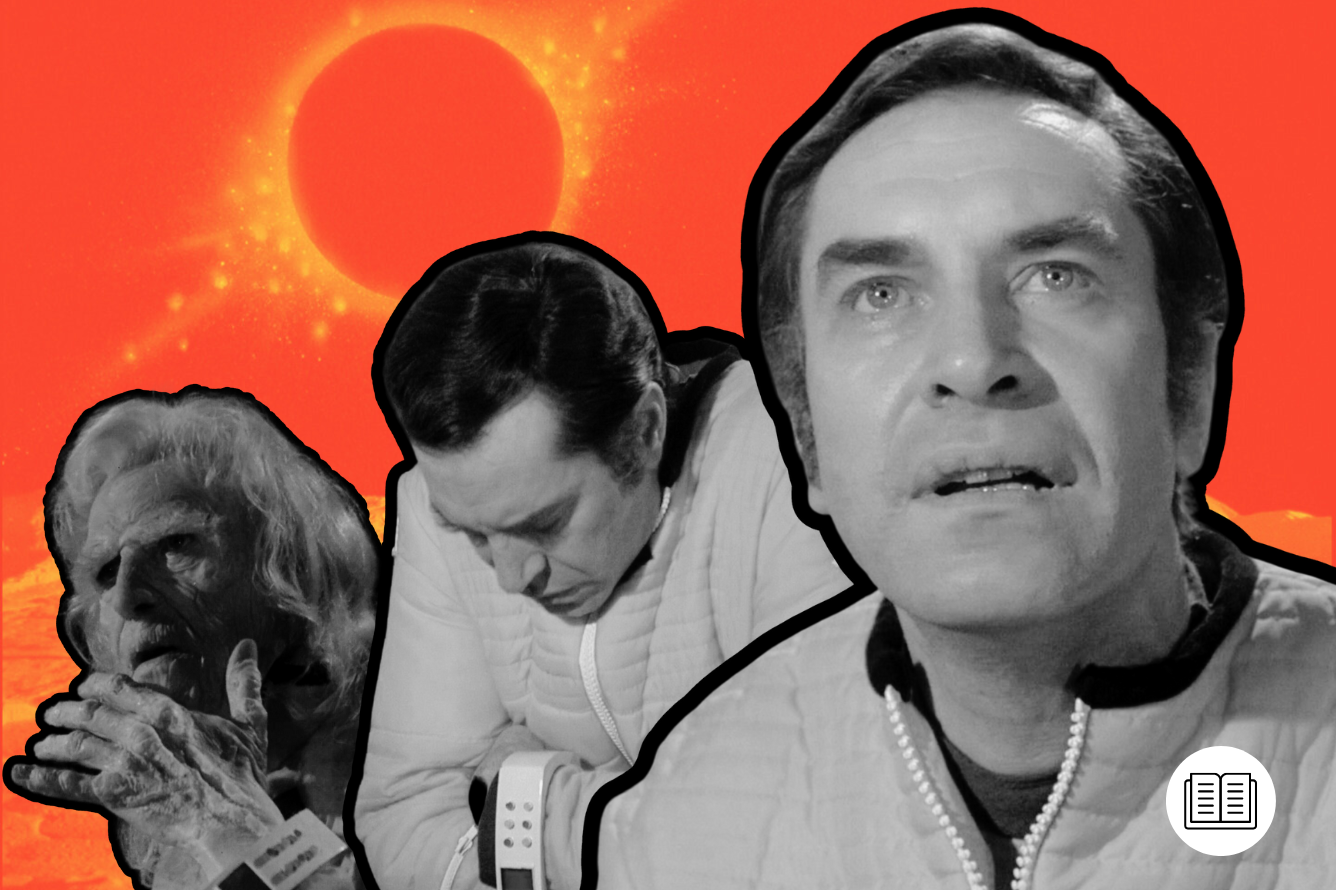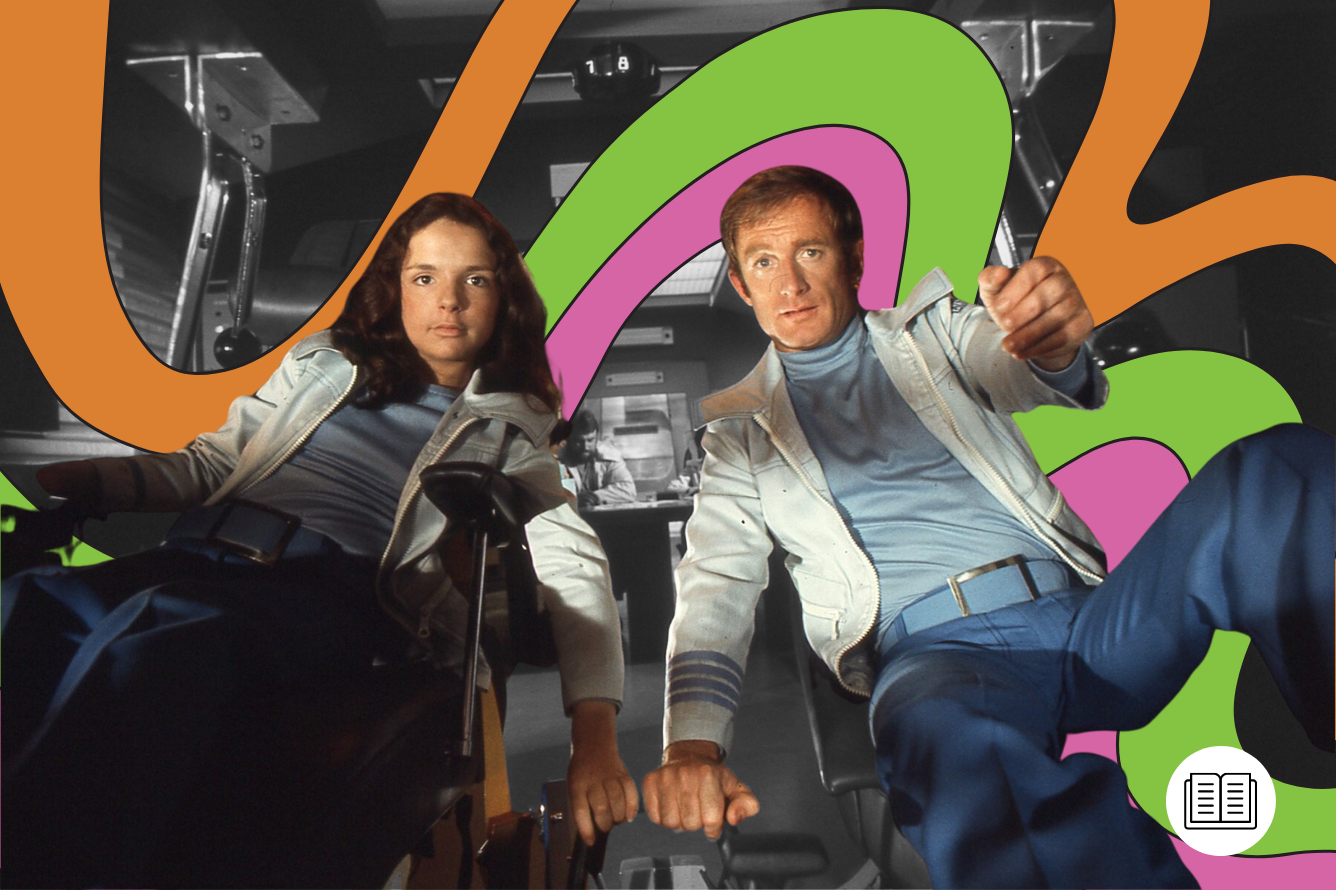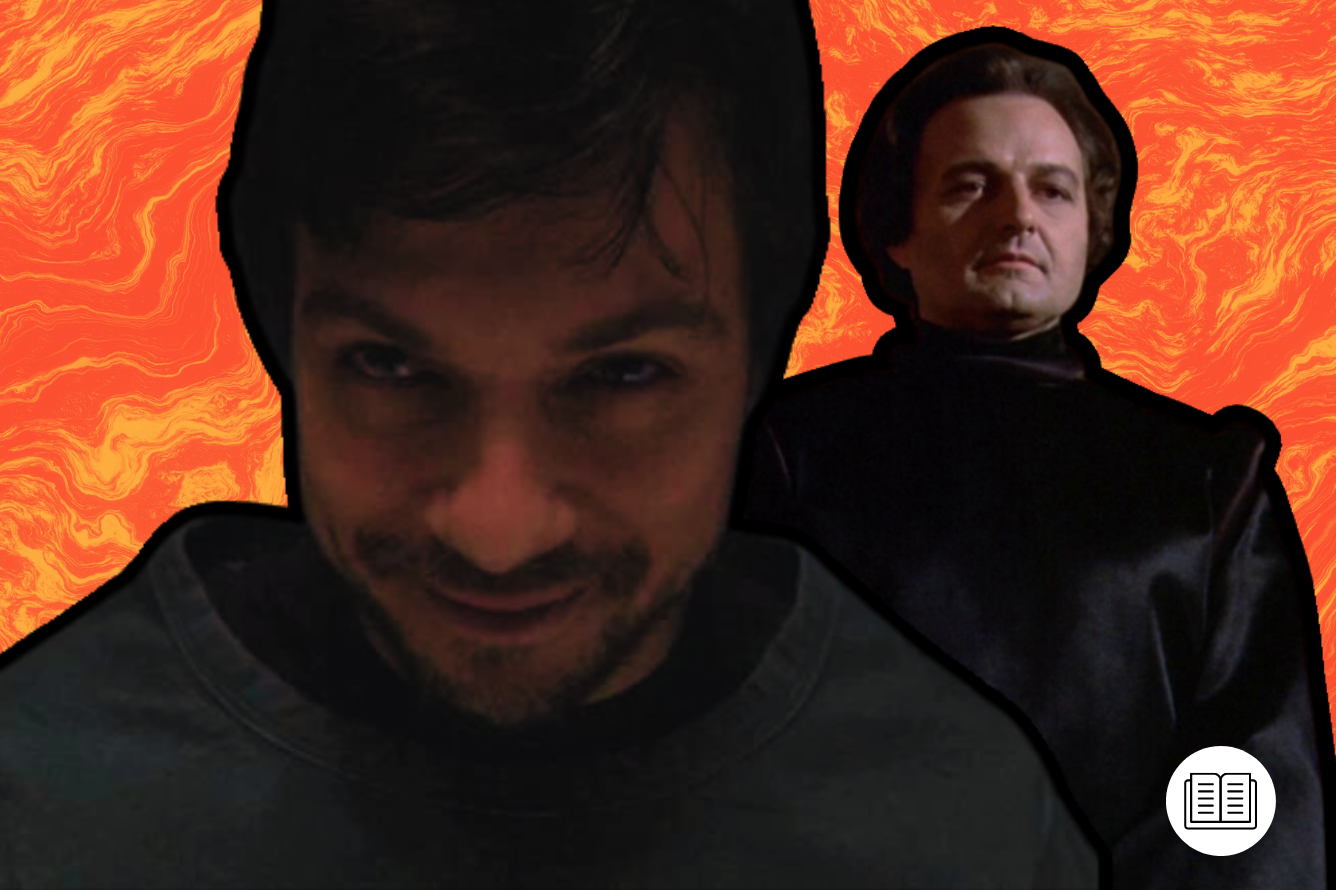Last November 30, we awoke to the outwardly alarming news that a black hole was aimed right at Earth. “Earlier this year, astronomers at the Palomar Observatory detected an extraordinary flash in a part of the sky where no such light had been observed the night before,” reported the University of Utah. “From a rough calculation, the flash appeared to give off more light than 1,000 trillion suns.”
After studying a quartet of spectra, researchers concluded that AT 2022cmc had been generated by “a relativistic jet of matter launched by a supermassive black hole at close to the speed of light. They believe the jet is the product of a black hole that suddenly began devouring a nearby star, releasing a huge amount of energy in the process.”
This was the biggest tidal disruption event (TDE) ever recorded, tearing a star to pieces in its force. Its brightness enabled it to be seen from a greater distance than any black hole before, some 8.5 billion light years away. That’s just a hop, skip, and a jump for Space: 1999’s Moonbase Alpha, whose encounter with a black hole is the meat of our story.
Lucky us, were able to see AT 2022cmc so clearly because the jet of the black hole is pointing straight for us. “We know there is one supermassive black hole per galaxy, and they formed very quickly in the universe’s first million years,” said MIT postdoctoral student Matteo Lucchini, putting a positive spin on the news. “That tells us they feed very fast, though we don’t know how that feeding process works. So, sources like a TDE can actually be a really good probe for how that process happens.”
The proximate cause of this TDE was a star tumbling into the accretion disc of AT 2022cmc, described as “a whirlpool of debris” falling into the black hole. As for the jet of matter, it was moving just under the speed of light in what astronomers called a “hyper-feeding frenzy.”
It’s Hungry, Too
“It’s probably swallowing the star at the rate of half the mass of the sun per year,” opined MIT Einstein Fellow Dheeraj Pasham. “A lot of this tidal disruption happens early on, and we were able to catch this event right at the beginning, within one week of the black hole starting to feed on the star.”
British astronomy boffins added the comforting news that galaxy PBC J2333.9-2343, where all this was taking place, had changed direction and was moving closer to Earth. To look on the bright side, they noted that the galaxy is still 657 million light-years distant. It was, they said, a “blazar,” a super-black hole, which is kind of a catchy handle for a sun-sucking force.
Still, it’s just one out of 100 million black holes wandering the Milky Way, and nothing one should lose sleep over. One scientist called AT 2022cmc’s aim “just dumb luck.” Perhaps we should fret about the closer Sagittarius A instead. Wherever they are, black holes are so intense that light itself cannot escape them, let alone Moonbase Alpha. This makes its close scrape in ‘Black Sun’ (S1, Ep3) all the more a matter of metaphysical mind over stellar matter.
Science fiction fans of a certain stripe love to tear their hair out and rend their garments over the scientific impossibilities and cosmic whimsies of Space: 1999. But it doesn’t take even a close reading of the show to see that it is far less concerned with scientific issues than what expedition leader John Koenig (Martin Landau) will call, in a later episode, “This question of the destiny of man.”
But of course, spiritual allegories are something that conventional television far is ill-equipped to contend with, necessitating the sci-fi prism. (Ronald D. Moore’s Battlestar Galactica is a shining example of this.) So Gerry and Sylvia Anderson launched the inhabitants of Moonbase Alpha on an intergalactic slalom, in search of mankind’s fate. The series had already grappled with nuclear waste (‘Breakaway’ – S1, Ep1) and the afterlife (‘Matter of Life and Death’ – S1, Ep2). Why not meet God?
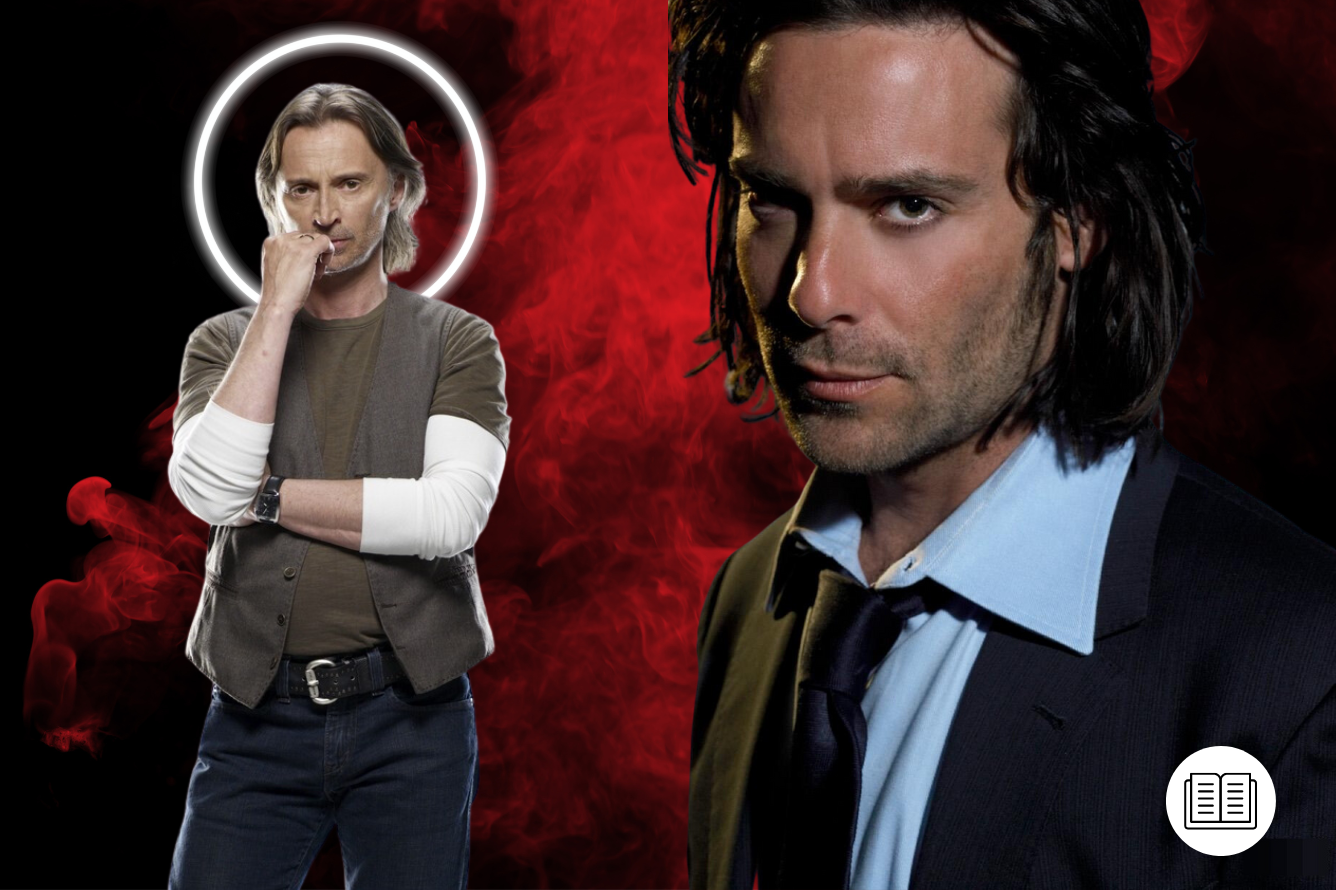
Just Another Day on Moonbase Alpha
The cold opening of ‘Black Sun’ finds our heroes trying to dodge a caroming asteroid. Defying the laws of physics it shifts from a parallel course with Alpha to a collision path. “What’s the problem, John,” asks Dr. Victor Bergman (Barry Morse), strolling into Main Mission impossibly cool and collected. The asteroid is yanked away just seconds from crushing Alpha—and into the maw of a black hole, or “black sun,” as scriptwriter David Weir (with an assist from Christopher Penfold) prefers to name it.
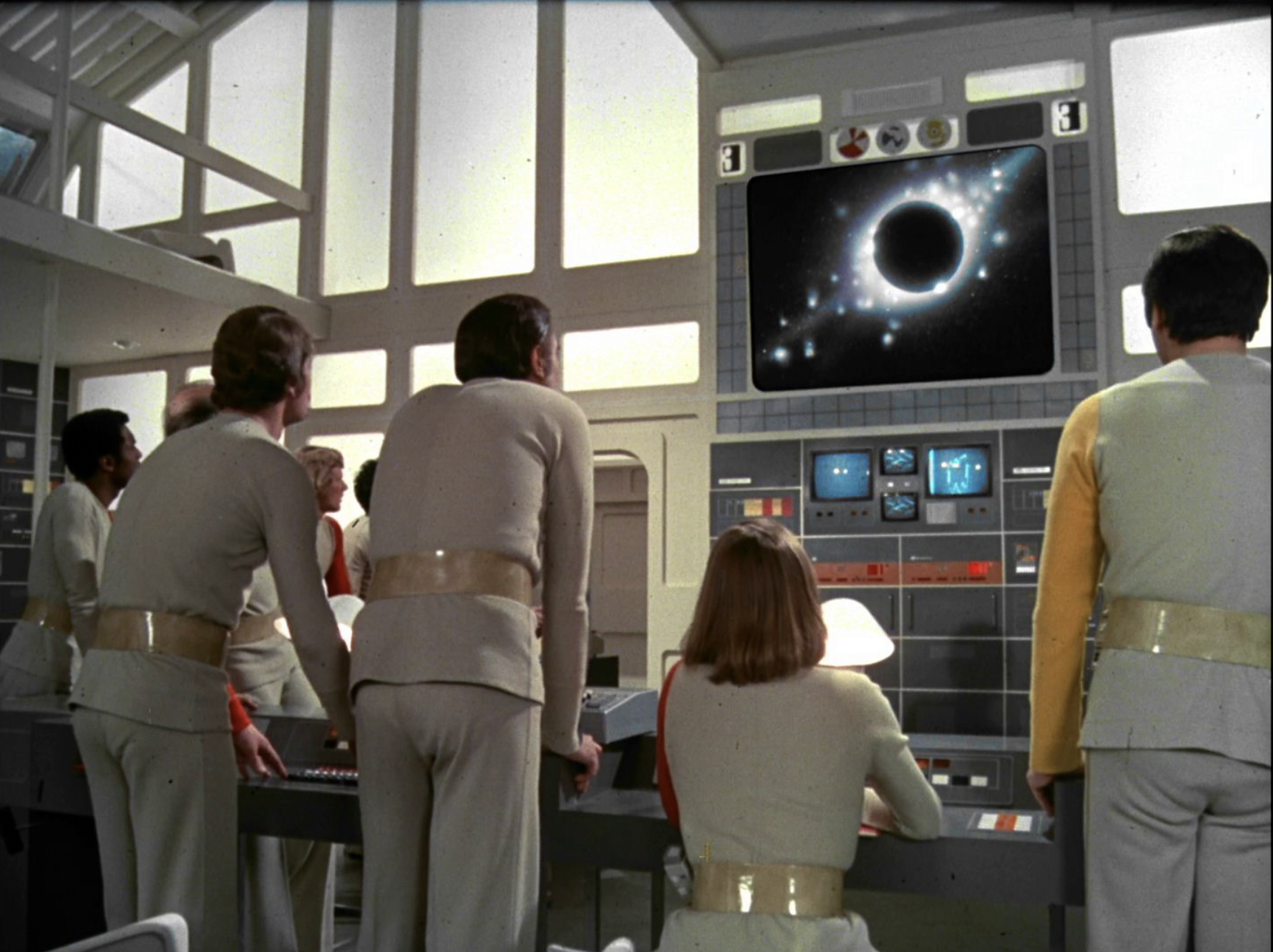
“It’s round. It’s huge and it’s black. Boy, is it black,” marvels pilot Mike Ryan (Paul Jones) as he pilots his Eagle inadvisedly toward the aperture. Koenig tries to draw him back but Ryan pushes on, exuding ill-assumed confidence with a shit-eating grin and a jaunty, “All it has is a lot of gravity… What’s the problem?” Well, the dense gravity is the problem, and that foolhardy grin is soon plastered on the other side of Ryan’s face as the black hole sucks him in and blows up his Eagle.
Koenig comes to the sudden realization that “We’ll all be dead in three days.” Bergman briefs the staff on black-hole physics, saying, “Just a handful of the stuff can outweigh several elephants.” (Which may be putting it lightly.) He does, however, have a plan, to interlock the station’s eight antigravity towers to create a force field over Alpha, cannibalizing nearly all the Eagle generators to power his scheme.
“It’s a long shot but there’s nothing else we can do,” says Koenig. “It’s ingenious,” marvels Dr. Helena Russell (Barbara Bain), to which Bergman replies, “It’s insane.”
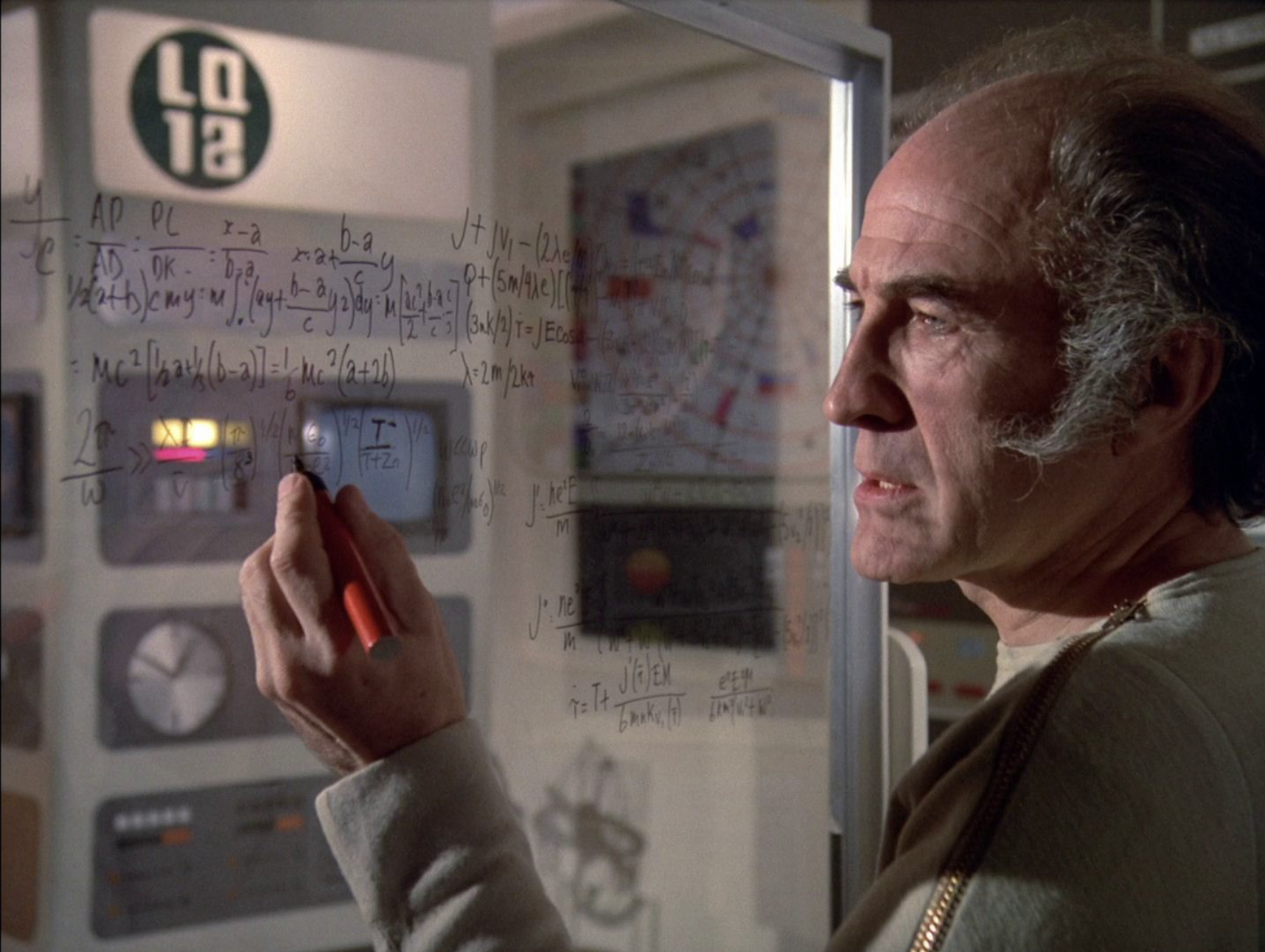
Bergman and Koenig are soon slo-mo sprinting across the lunar surface, as part of a high-risk demonstration of the former’s deflector beams. “Victor, we really shouldn’t be out here,” says Koenig, speaking for the TV audience as well. “Well,” Bergman muses, “it’s the only way to make our point.” And they do. An Eagle piloted by Alan Carter (Nick Tate) bounces harmlessly off the anti-gravity screen. But Dr. Russell is not amused and chastises them like naughty children …
Dr. Helena Russell: (after seeing Carter fire a laser at the duo) What incredible stupidity! The risk to both of you!
John Koenig: Helena, it was all for morale. It proved nothing. The forces inside a black sun are inconceivable. They’re capable of anything. They can bend space, even time, turn both inside out.
Dr. Helena Russell: Then what’s the point of the force field?
Dr. Victor Bergman: The same point that prevents you from giving up on a patient, until he’s dead.
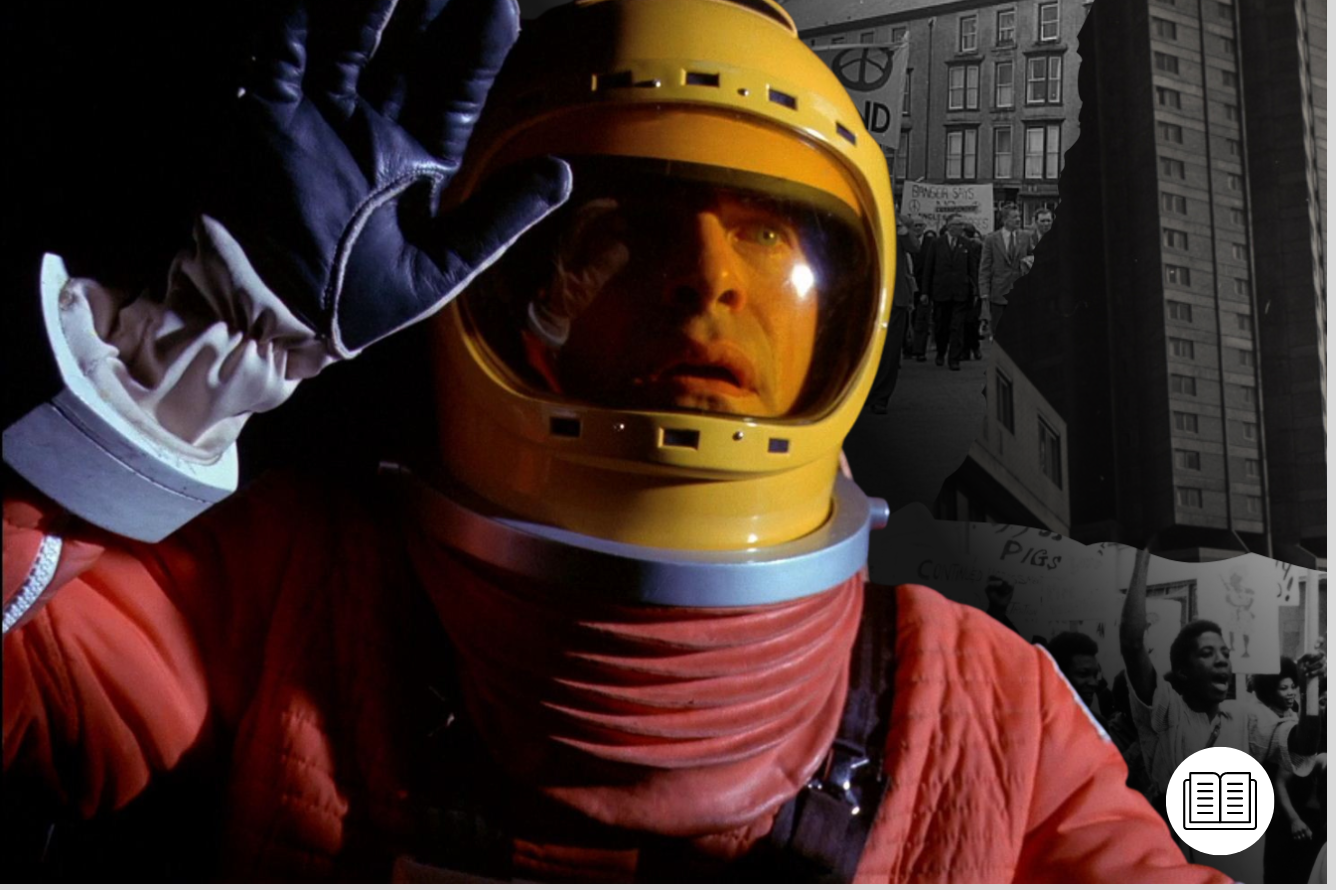
Desperate Measures in ‘Black Sun’
Koenig pitches a scheme to launch a “lifeboat” in the form of Eagle Five to ferry a handful of Alphans to safety. But more pressing concerns are the cold brought about by power-conservation measures (most energy being shunted into the force field), which is crimping all-seeing Computer’s style. She browbeats David Kano (Clifton Jones) as a fishwife would a henpecked husband, epitomizing their abusive/codependent dynamic…
Computer: (snippily) Reprogramming calculations conflicted with previous orders.
David Kano: You should have said so! It’s your responsibility. If it takes more power, then say so!
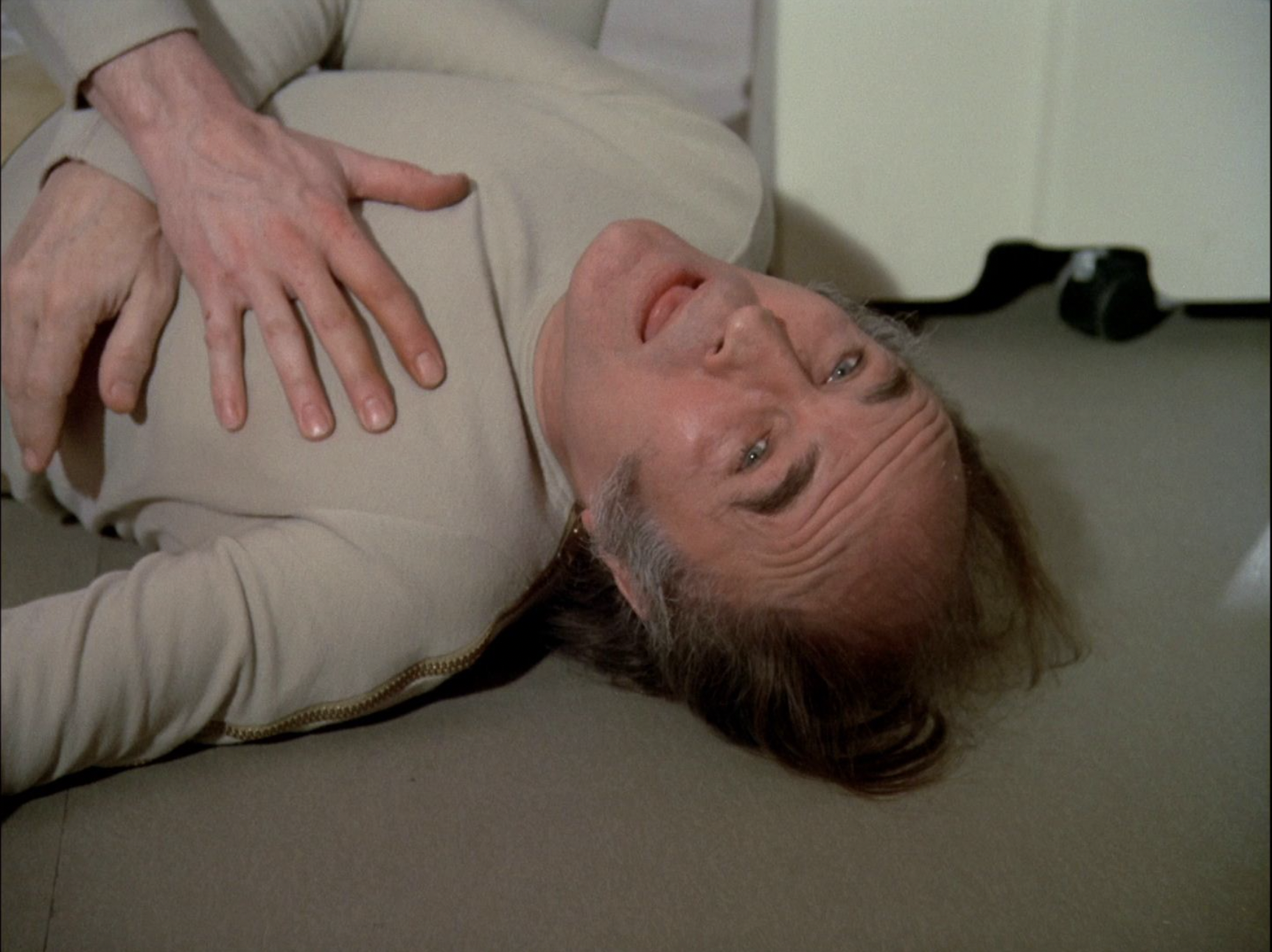
The drain of the black hole is not only siphoning off energy from Alpha, but it’s also halving the timeline before the collision. Since Plan A never works in science fiction, one of Bergman’s towers fails during an unnecessary test ordered by Koenig. The short circuit nearly kills Bergman himself, his near-death experience prevented—or so Dr. Russell tells him—by his artificial heart. Now, why a power surge shouldn’t haven’t fried “your mechanical heart” goes unexplained. Also, the damage to the force field is repaired without further mention.
Amidst all this handwaving, we learn that Alpha is but four hours away from intersection with the black hole. Sending out Eagle Five so close to the accretion disc seems like a suicide mission but Koenig does it anyway. However, the survival-ship mission doesn’t sit entirely well with doughty Carter…
Alan Carter: Commander, I’ve got to talk to you. What’s this about a survival ship? Is somebody going somewhere?
John Koenig: Somewhere? Yes.
Alan Carter: Did you know about this? You, Sondra? I didn’t believe it! Eagle Five is fully loaded and ready to go, and I was not informed, Commander. None of us were! I can’t speak for the rest but I care about dying, how I die. Staying here on Alpha along with everybody—I’d already accepted that. But now there’s going to be six or seven lives on that ship.
John Koenig: Six.
Alan Carter: Well I should be one of those six, Commander, because if anyone can get them somewhere, I can.
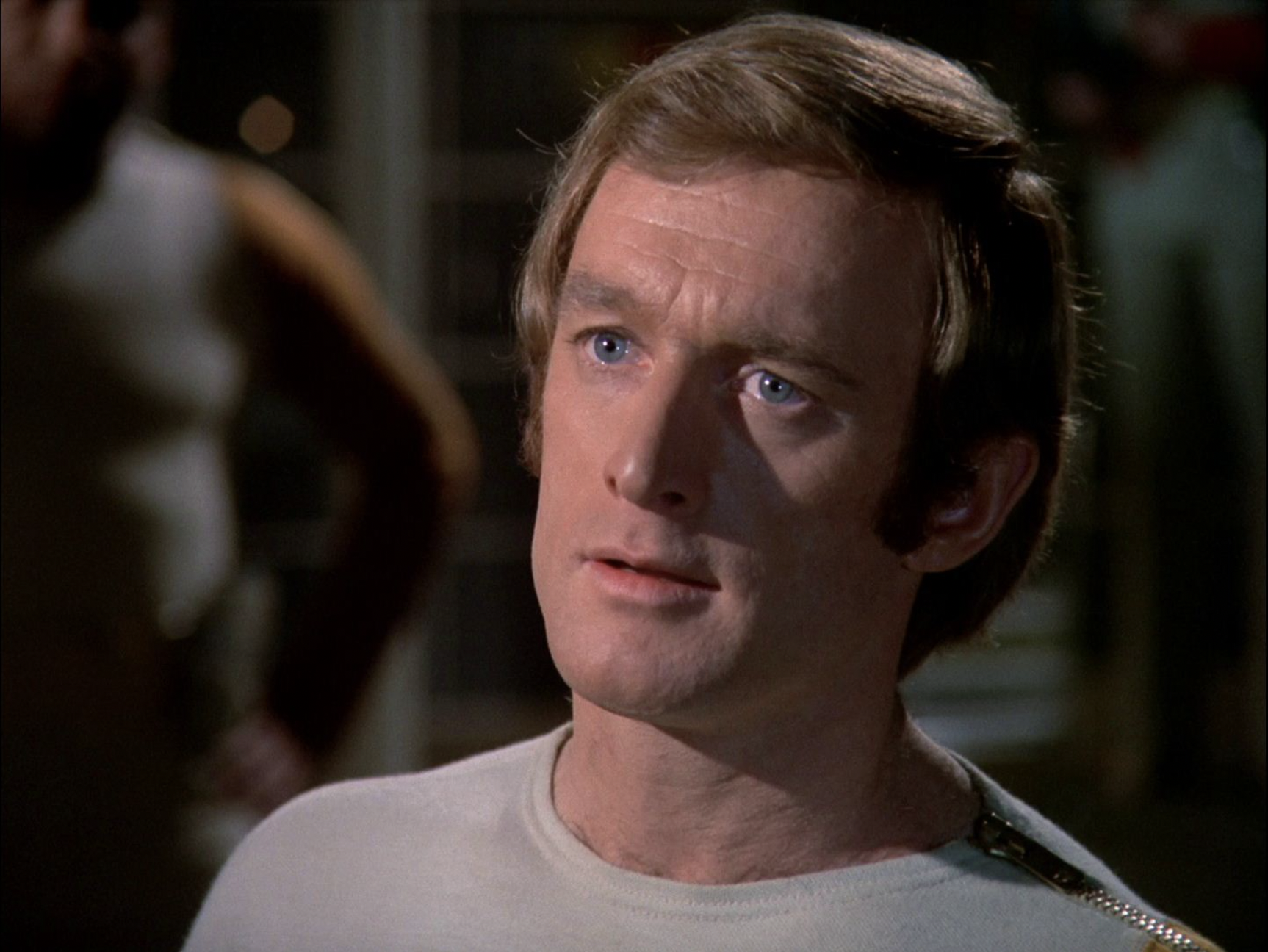
Gotta love that Nick Tate. Carter’s Australian obstinacy endeared him to fans and spared the pilot from a Season 2 demise at the hands of incompetent then showrunner Fred Freiberger. (Don’t get us started on Season 2.) In any event, Carter, Russell, and Sandra Benes (Zienia Merton) all get the nod to fly out on Eagle Five. A pining Dr. Russell, missing Koenig already, is told by Bergman, “You knew he wouldn’t go.” Koenig gives them five weeks to find another habitable planet, good odds given Moonbase Alpha’s one-planet-per-episode trajectory.
Paul Morrow (Prentis Hancock) escorts Sandra to the launch pad…
Sandra Benes: It was thoughtful of you to come, Paul. You didn’t have to.
Paul Morrow: I wanted to. (They embrace)
Alan Carter: I’ll send you a postcard.
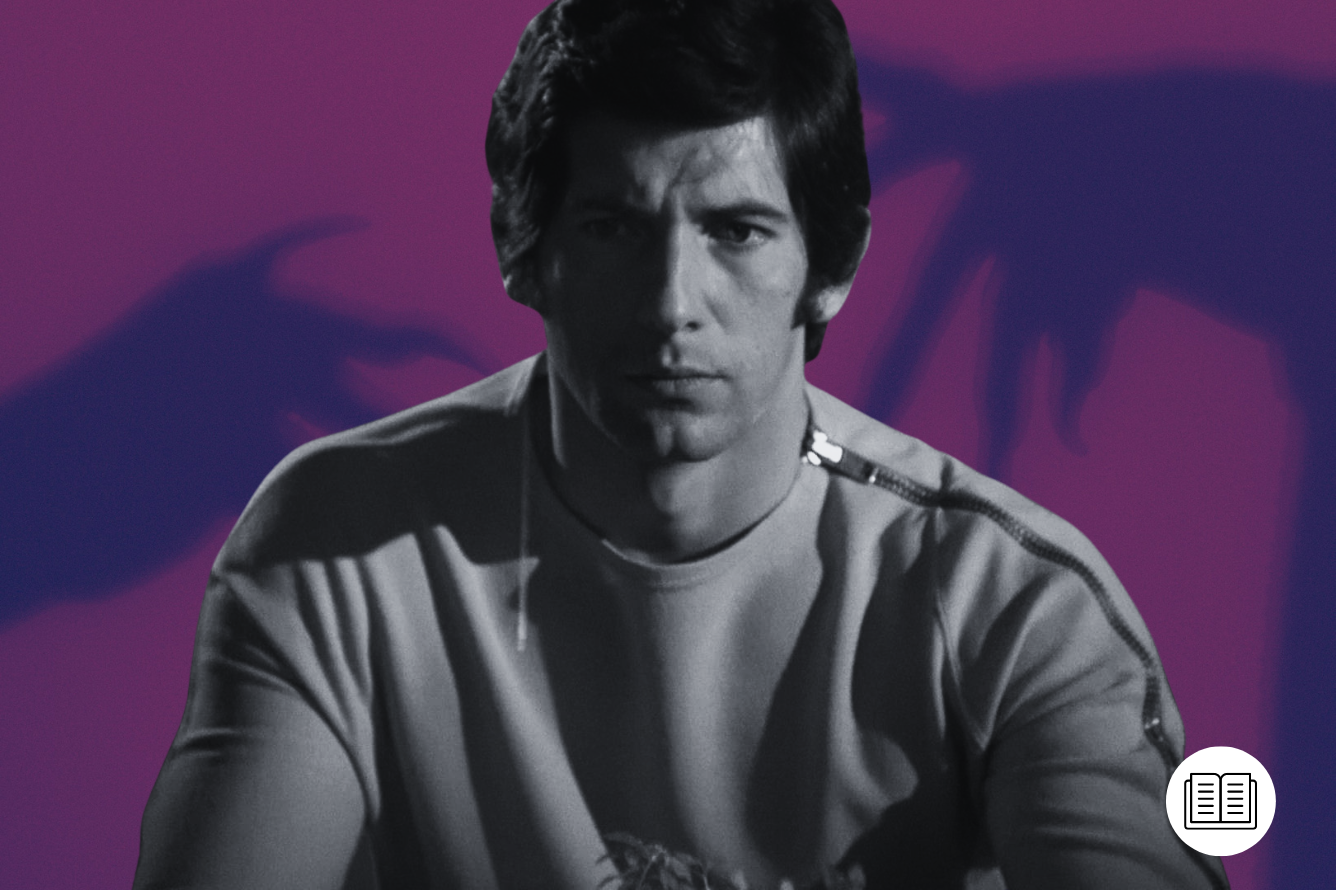
Face to Face With Eternity in ‘Black Sun’
Despite what has to be kissing distance to the black hole, Carter lifts off successfully. Back in Koenig’s office, Bergman arrives bearing a bottle of 1939 brandy and a cigar, despite doctor’s orders to swear off smoking. (“Oh, I don’t think Dr. Russell would object,” Bergman tells Koenig.) Their impending mortality causes Koenig and Bergman, especially the latter, to muse upon the Alphans’ unlikely survival.
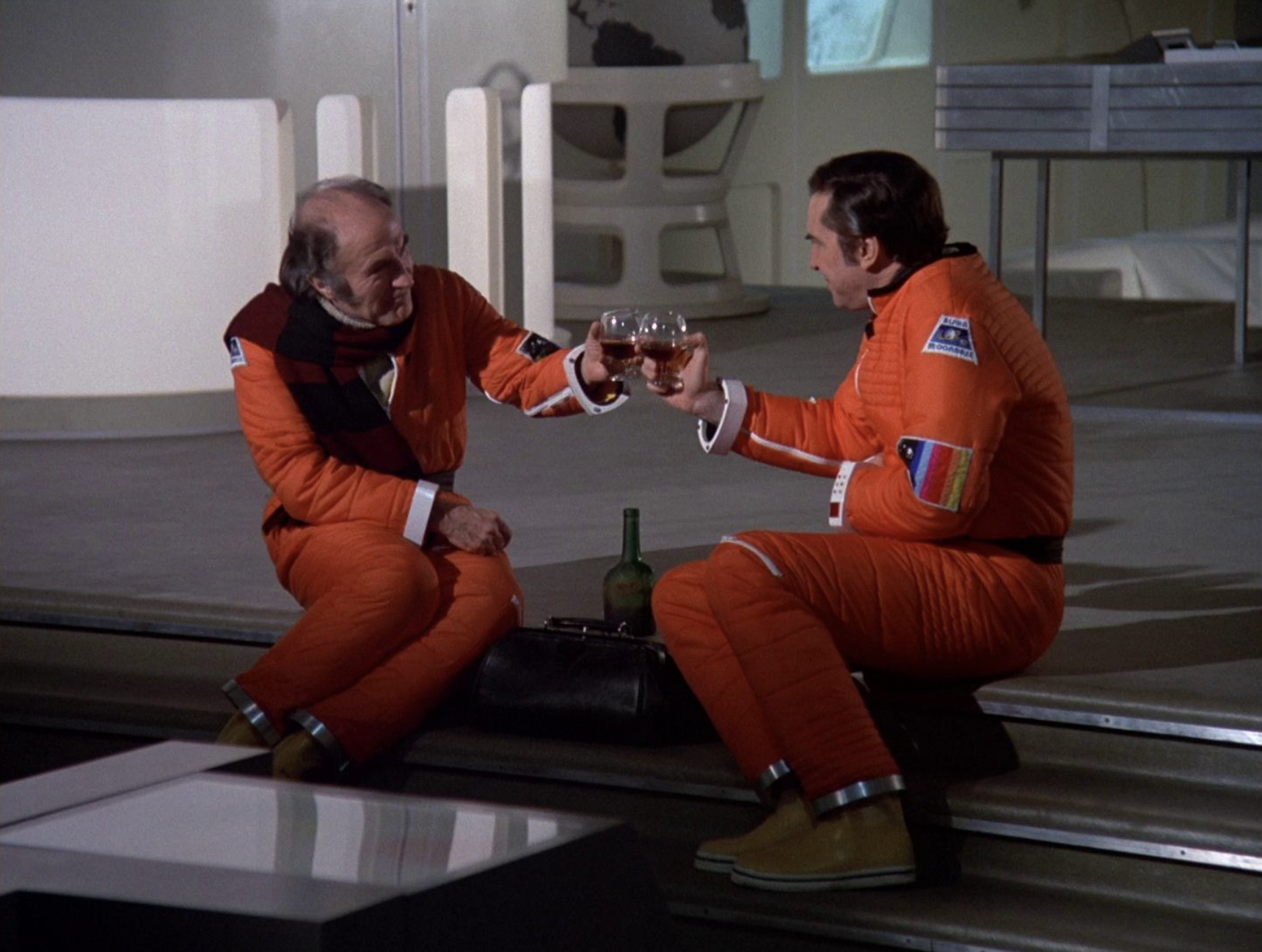
As the scientist observes, they should have been dead many times over, especially after the atomic-waste detonation of “Breakaway,” the event that caused their hejira through the cosmos. Koenig isn’t quite ready to face death yet but Bergman persists …
Victor Bergman: John, have you ever wondered just how and why we’ve survived?
John Koenig: Not until now.
Victor Bergman: You got any answers?
John Koenig: You’re not referring to God, aren’t you?
Victor Bergman: I don’t exactly know, I-I-I’m a scientist. I don’t know anything about God. Cosmic intelligence is what I’ve got in mind …
John Koenig: … which intervenes at the right moment.
Victor Bergman: That’s one answer. Ultimately, I suppose we all believe what we want to believe. Perhaps that’s what reality is. One thing, though. The line between science and mysticism is just a line. Sometimes it makes me feel quite old.
He doesn’t realize just how old he is soon going to feel. In the now-deserted and dark Main Mission, Koenig and Bergman exchange toasts. The commander pessimistically sighs, “To everything that might have been.” Bergman, always the humanist, rejoins “To everything that was.”
As director Lee H. Katzin cranes back to a long shot of Landau and Morse, he cuts to a montage of how the Alphans spend what they believe are their last moments. Smitty (Jon Laurimore) plays poker, employing square chips. Kano and Dr. Paul Mathias (Anton Phillips) grimly battle at chess on a glass table, with Katzin shooting their game from underneath. “You’ll never beat me, you know,” Mathias warns ominously. Morrow strums a guitar pensively, soon to be joined by a female Alphan—and the prospect of last-minute booty call?
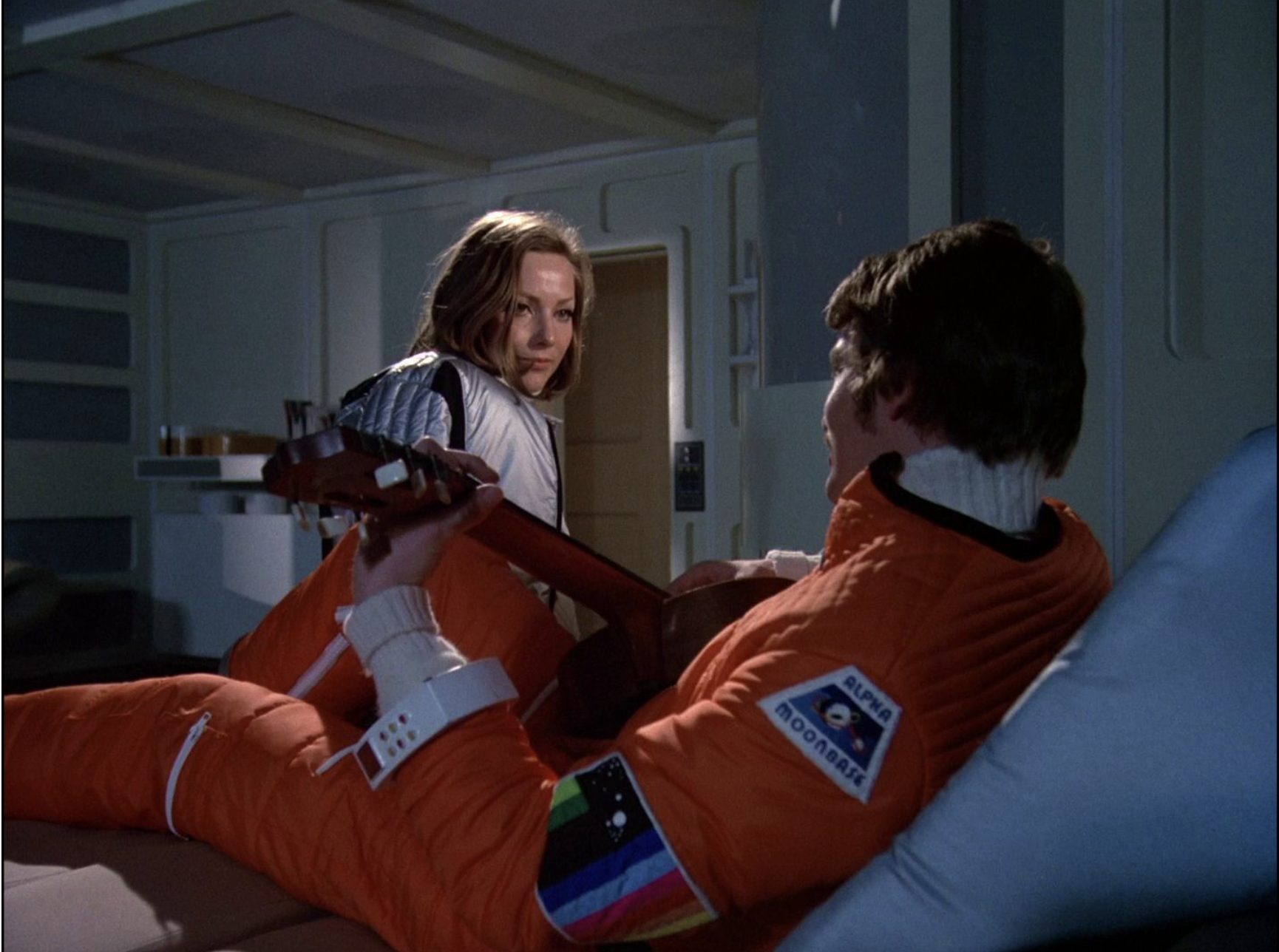
Katzin films the whole episode gorgeously but this would be his last stint on Alpha, possibly due to the slow pace at which he shot the pilot. Whatever the reason, Katzin did not endear himself to producer Sylvia Anderson, as she makes abundantly clear in her US DVD commentary for ‘Testament of Arkadia’ (S2, Ep24). British directors would be the rule for the remainder of the series.
‘Black Sun’s Conversations with God
As the moon enters the accretion disc, Koenig and Bergman become transparent, then age scores—if not hundreds of years. (Barry Gray’s scoring is particularly beautiful here.) The old age makeup gives the men a simian aspect, but such cosmetic misfires would also be a 21st-century phenomenon, as anyone who has seen Stargate SG-1’s ‘Unending’ (S10, Ep20) can vouch.
Koenig and Bergman debate whether or not they even exist any longer, as Katzin uses dazzling lights and glitter to convey the ineffable. The two men’s pondering of unified field theory is interrupted by a non-corporeal, female voice …
John Koenig: If everything is everything else, then the whole universe is living thought.
Cosmic Voice: That is true.
Victor Bergman: Who are you?
Cosmic Voice: A friend. Come with me.
John Koenig: Every star is just a cell in the brain of the universe.
Cosmic Voice: That is a lovely way to understand it.
Victor Bergman: Why have I never talked with you before?
Cosmic Voice: Because of time. You think at what you call the speed of light. In eternity I have no hurry. I think a thought perhaps in every thousand of your years. You are never there to hear it.
Victor Bergman: Are you … God?
Cosmic Voice: It was good to have known you.
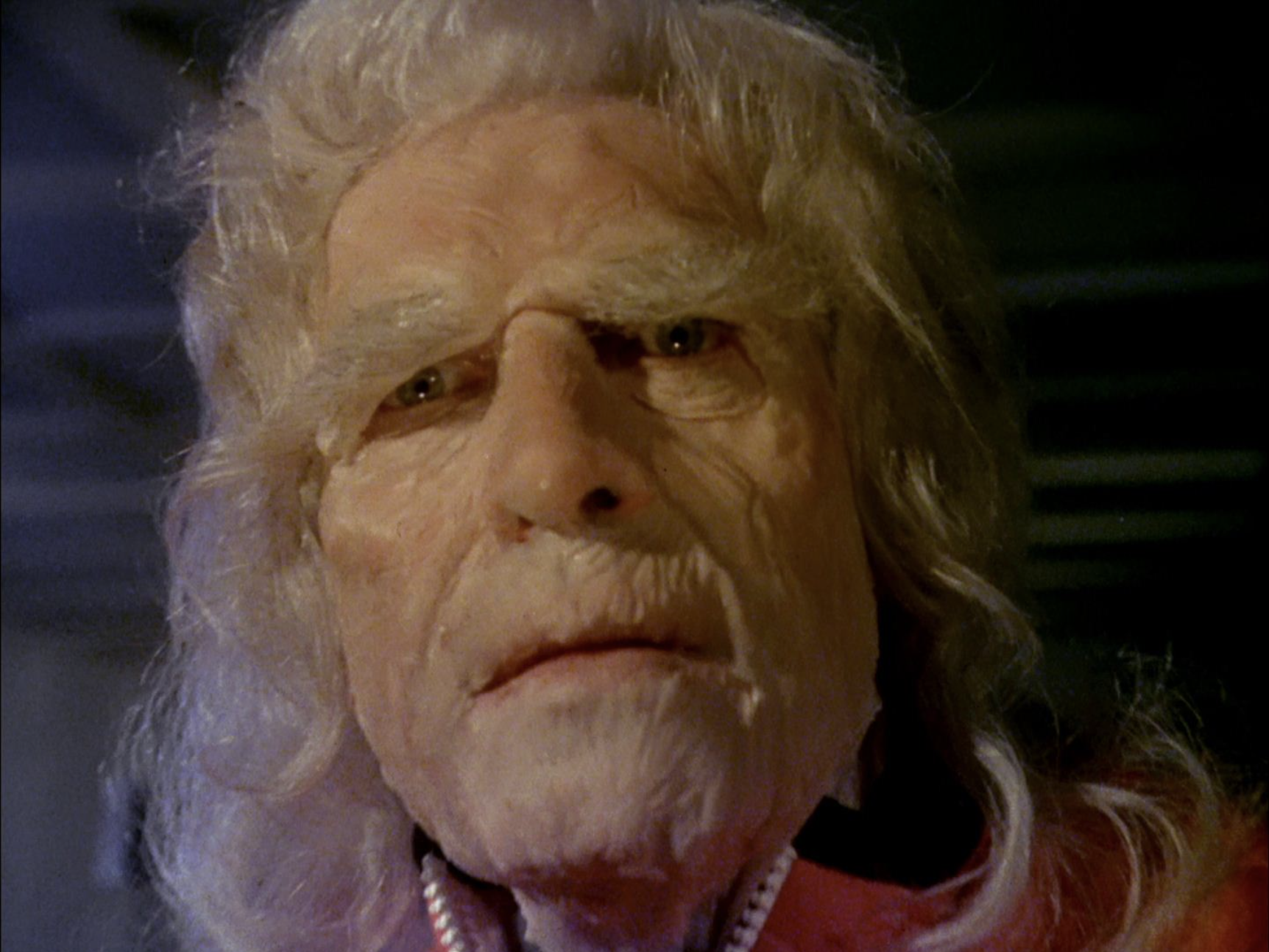
But the moment will not last. It was quite audacious of Space: 1999 to posit a feminine Creator, especially in 1975. Nor would this be the last time. Koenig would meet a sibylline goddess, Aura, played by Margaret Leighton in ‘Collision Course’ (S1, Ep13). Alas, the Alphans would encounter “the brain of the universe” in an eponymous episode (‘Space Brain’ – S1, Ep20) and involuntarily kill it. Does this mean God is dead? For those who continue on through ‘Testament of Arkadia’ the answer is no.
(Author’s Note: The Internet Movie Database places “Collision Course” third in the Space: 1999 viewing order and “Black Sun” tenth. For purposes of this essay, we defer to the sequence of A&E’s Blu-Ray set.)
Back to Earth, After a Fashion
Unfortunately, metaphysics would be banished in favor of cloth monsters in the Freiberger season, substituting what some have called “science fiction for network television” for “science fiction for PBS.” For those who enjoy ‘Black Sun’ despite its impossibilities, this is too depressing to contemplate.
There remains the matter of the lifeboat. Koenig, restored to his normal state, is apparently none the wiser for his encounter with eternity. “No sign of the survival ship,” he grouses to Bergman. “So much for your theories of cosmic intelligence.” “Well, I knew it was impossible,” the latter shrugs. But something on the Main Mission monitor makes a believer of Koenig: “Was it?”
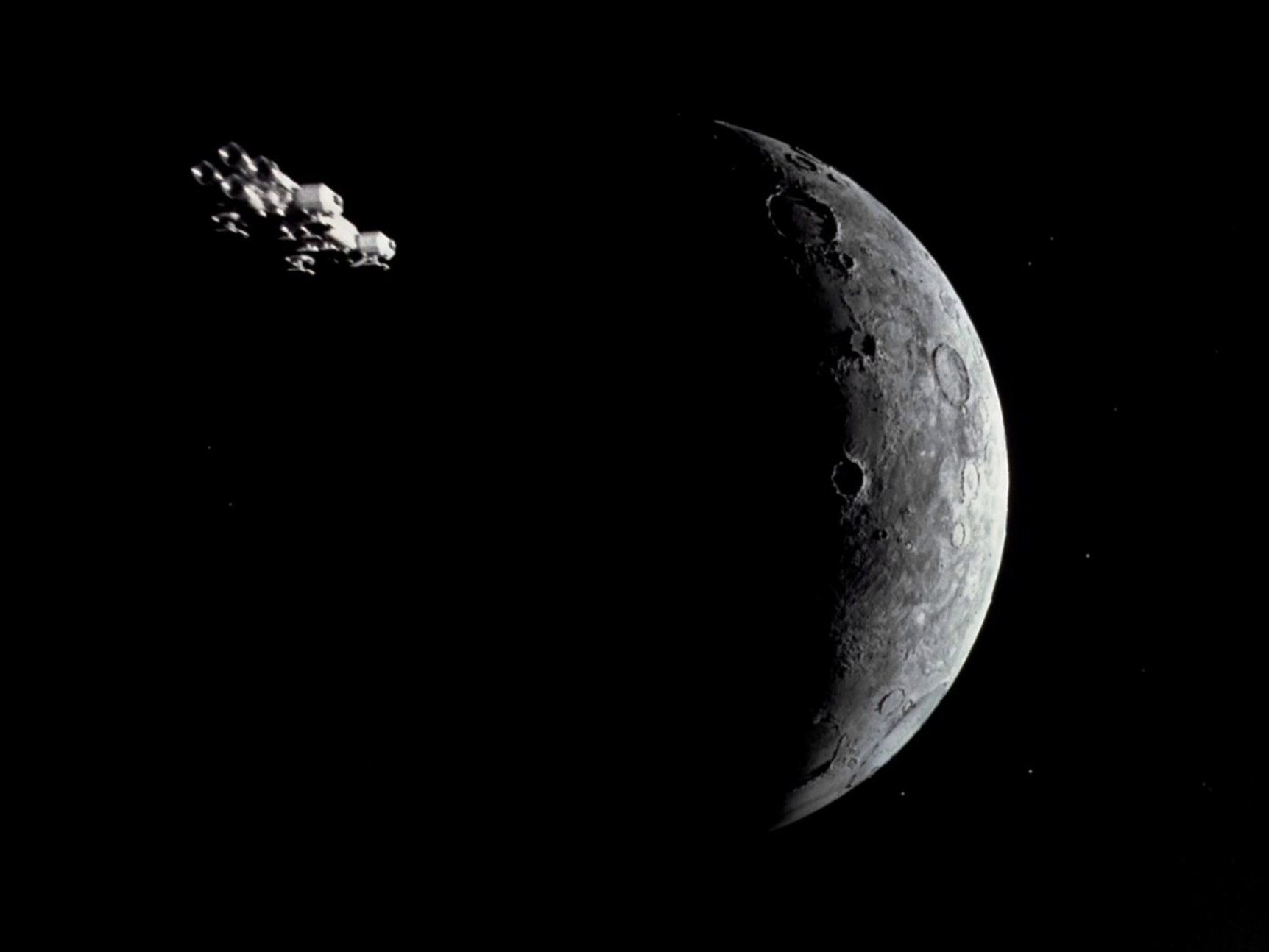
Yes, Eagle Five has returned, despite having headed steadily away from Alpha. What’s more, space and time have indeed been bent or folded, as the moon has passed through the black hole to find itself on the far side of the galaxy, a million light years from its previous position, its inhabitants none the older for it. “Something brought us home,” says Russell, admiring the inexplicable.
General jubilation reigns, with Bergman following the happy crowd down the corridor, flicking cigar ash on the Alpha carpet. He’s earned it.
The cost of your membership has allowed us to mentor new writers and allowed us to reflect the diversity of voices within fandom. None of this is possible without you. Thank you. 🙂


